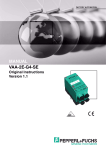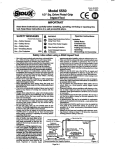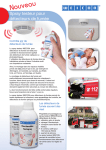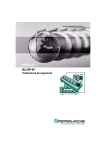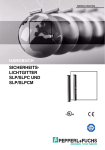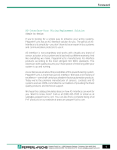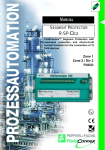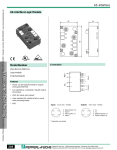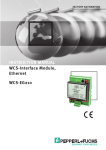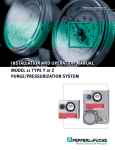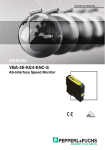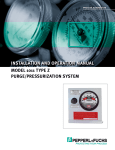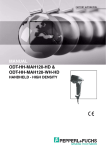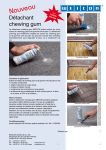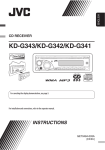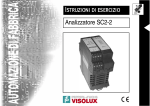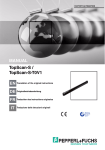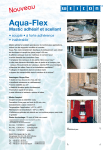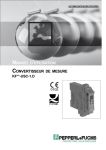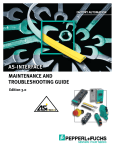Download INSTRUCTION MANUAL AS-Interface Safety at Work VAA-2E
Transcript
FACTORY AUTOMATION
INSTRUCTION MANUAL
AS-Interface Safety at Work
VAA-2E-G4-SE
Version 1.0
With regard to the supply of products, the current issue of the following document is applicable: The General
Terms of Delivery for Products and Services of the Electrical Industry,
published by the Central Association of the "Elektrotechnik und Elektroindustrie (ZVEI) e.V.
in their most recent version as well as the supplementary clause: "Extended reservation of title".
We at Pepperl+Fuchs recognise a duty to make a contribution to the future,
For this reason, this printed matter is produced on paper bleached without the use of chlorine.
VAA-2E-G4-SE
Table of contents
1
Declaration of conformity . . . . . . . . . . . . . . . . . . . . . . . . . . . . . . . . . . . . 2
2
Symbols used in this document . . . . . . . . . . . . . . . . . . . . . . . . . . . . . . . 3
3
Safety . . . . . . . . . . . . . . . . . . . . . . . . . . . . . . . . . . . . . . . . . . . . . . . . . . . . 4
3.1
3.1.1
3.1.2
3.1.3
Intended use . . . . . . . . . . . . . . . . . . . . . . . . . . . . . . . . . . . . . . . . . . . . . . . . . . . . . .
Safety Monitor requirements . . . . . . . . . . . . . . . . . . . . . . . . . . . . . . . . . . . . . . . . . .
Wiring requirements . . . . . . . . . . . . . . . . . . . . . . . . . . . . . . . . . . . . . . . . . . . . . . . . .
Light grids and light curtains . . . . . . . . . . . . . . . . . . . . . . . . . . . . . . . . . . . . . . . . . .
3.2
General safety instructions . . . . . . . . . . . . . . . . . . . . . . . . . . . . . . . . . . . . . . . . . 5
3.3
Transfer time of safety relevant information . . . . . . . . . . . . . . . . . . . . . . . . . . . . 5
3.4
PFD-Calculation . . . . . . . . . . . . . . . . . . . . . . . . . . . . . . . . . . . . . . . . . . . . . . . . . . . 6
4
Operating Principles of the input channels . . . . . . . . . . . . . . . . . . . . . . 7
5
Connections and LED indications . . . . . . . . . . . . . . . . . . . . . . . . . . . . . 9
5.1
Connections . . . . . . . . . . . . . . . . . . . . . . . . . . . . . . . . . . . . . . . . . . . . . . . . . . . . . . 9
5.2
LED indication . . . . . . . . . . . . . . . . . . . . . . . . . . . . . . . . . . . . . . . . . . . . . . . . . . . 10
6
Interface properties . . . . . . . . . . . . . . . . . . . . . . . . . . . . . . . . . . . . . . . . 11
6.1
AS-Interface, auxiliary power . . . . . . . . . . . . . . . . . . . . . . . . . . . . . . . . . . . . . . . 11
6.2
Transmitter and receiver . . . . . . . . . . . . . . . . . . . . . . . . . . . . . . . . . . . . . . . . . . . 11
6.3
Shielding . . . . . . . . . . . . . . . . . . . . . . . . . . . . . . . . . . . . . . . . . . . . . . . . . . . . . . . . 11
6.4
6.4.1
6.4.2
6.4.3
Inputs . . . . . . . . . . . . . . . . . . . . . . . . . . . . . . . . . . . . . . . . . . . . . . . . . . . . . . . . . .
General . . . . . . . . . . . . . . . . . . . . . . . . . . . . . . . . . . . . . . . . . . . . . . . . . . . . . . . . .
Safety classification . . . . . . . . . . . . . . . . . . . . . . . . . . . . . . . . . . . . . . . . . . . . . . . .
Channel short circuit monitoring . . . . . . . . . . . . . . . . . . . . . . . . . . . . . . . . . . . . . .
7
Implementation . . . . . . . . . . . . . . . . . . . . . . . . . . . . . . . . . . . . . . . . . . . . 13
7.1
Configuration requirements for the safety monitor . . . . . . . . . . . . . . . . . . . . . 13
7.2
Installation . . . . . . . . . . . . . . . . . . . . . . . . . . . . . . . . . . . . . . . . . . . . . . . . . . . . . . 13
7.3
Module addressing . . . . . . . . . . . . . . . . . . . . . . . . . . . . . . . . . . . . . . . . . . . . . . . 14
4
4
4
5
12
12
12
12
Functionality Test . . . . . . . . . . . . . . . . . . . . . . . . . . . . . . . . . . . . . . . . . . . . . . . . 14
8
AS-Interface safety module . . . . . . . . . . . . . . . . . . . . . . . . . . . . . . . . . . 15
9
Certificates . . . . . . . . . . . . . . . . . . . . . . . . . . . . . . . . . . . . . . . . . . . . . . . 15
A
Summary of the requirements for categories . . . . . . . . . . . . . . . . . . . 16
Date of Issue
2005-09-07
7.4
Subject to reasonable modifications due to technical advances.
Copyright Pepperl+Fuchs, Printed in Germany
Pepperl+Fuchs Group • Tel.: Germany +49 621 776-0 • USA +1 330 4253555 • Singapore +65 67799091 • Internet http://www.pepperl-fuchs.com
1
VAA-2E-G4-SE
Declaration of conformity
1
Declaration of conformity
The AS-Interface-Safety-Module VAA-2E-G4-SE offering 2 safety inputs designed for
two-channel ESPE (electro sensitive protective equipment, for instance safety light
curtains and light grids) was developed and manufactured in observance of applicable European standards and regulations.
A declaration of conformity can be obtained from the manufacturer.
The manufacturer of this product, Pepperl+Fuchs GmbH in D-68307 Mannheim, retains a certified quality system in accordance with ISO 9001.
Date of Issue
2005-09-07
ISO9001
2
Subject to reasonable modifications due to technical advances.
Copyright Pepperl+Fuchs, Printed in Germany
Pepperl+Fuchs Group • Tel.: Germany +49 621 776-0 • USA +1 330 4253555 • Singapore +65 67799091 • Internet http://www.pepperl-fuchs.com
VAA-2E-G4-SE
Symbols used in this document
2
Symbols used in this document
This symbol warns of danger.
In the event the warning is ignored, the consequences may range from
personal injury to death of persons or from damage to destruction of
equipment.
This symbol warns of a possible fault.
Failure to observe may result in damage to the device or systems and
installations connected to it up to and including compete lack of proper
functionality.
Date of Issue
2005-09-07
This symbol brings important information to your attention.
Subject to reasonable modifications due to technical advances.
Copyright Pepperl+Fuchs, Printed in Germany
Pepperl+Fuchs Group • Tel.: Germany +49 621 776-0 • USA +1 330 4253555 • Singapore +65 67799091 • Internet http://www.pepperl-fuchs.com
3
VAA-2E-G4-SE
Safety
3
Safety
3.1
Intended use
The AS-Interface safety module permits the connection of one two-channel ESPE to
safeguard danger zones or areas in a system utilizing AS-Interface 'Safety at Work'.
It must be used as intended with a properly configured AS-Interface safety monitor
and a suitable ESPE (safety light curtain or light grid with electronic OSSDs.) This
allows the implementation of safety applications up to Category 4 according to
EN 954-1 and/or SIL 3 according to EN/IEC 61508 as well as Type 4 based on
EN/IEC 61496-1.
The safety requirements for the application are determined by either a risk analysis
(i. e. based on EN 1050) or derived from a C-standard.
In addition to the instructions included in this user manual, all applicable safety requirements, standards and regulations as well as operating instructions for the connected peripheral devices must be considered.
Protection of operating personnel and equipment is not ensured if the
module is not used in accordance with its intended use.
3.1.1 Safety Monitor requirements
The module shall only be used as a safty slave in an AS-Interface network and must
be connected to a suitable AS-Interface safety monitor. All instructions in the user
documentation must be followed. The AS-Interface monitor must fulfill the requirements of the system specifications version 2.01 dated 12.05.2000 ("Spezifikation der
sicheren AS-Interface-Uebertragung") or higher.
In order to evaluate a safety related function based on a safety standard all components of the function have to be evaluated according to the same safety standard.
The correct execution of a desired safety function also depends on the proper connection and configuration of the AS-Interface safety monitor. This also applies to the
desired reaction when safety codes are corrupted or the unit exhibits a hardware fault
(refer to the documentation of the AS-Interface safety monitor). The safety function
(including all attached safety devices) must be tested before the first startup. The
minimal requirement for the safety classification of the safety monitor needs to match
the safety classification required by the application.
Wires have to be safeguarded against simultaneous short circuit connections of the
inputs SE1 and SE2 to the positive supply.
4
Subject to reasonable modifications due to technical advances.
Copyright Pepperl+Fuchs, Printed in Germany
Pepperl+Fuchs Group • Tel.: Germany +49 621 776-0 • USA +1 330 4253555 • Singapore +65 67799091 • Internet http://www.pepperl-fuchs.com
Date of Issue
The demands of the EN/IEC 60204-1 (or similar standard) must always be considered. The requirements for the external wiring and the selection of connected safety
devices depend on the desired functionality as well as on the required safety classifications (EN 954-1 or EN/IEC 61508).
2005-09-07
3.1.2 Wiring requirements
VAA-2E-G4-SE
Safety
3.1.3 Light grids and light curtains
Safety systems must use ESPEs that satisfy EN/IEC 61496-1 and offer short-circuit
protection between channels. Type SLC and SLPCM light curtains (devices with an
integrated controller) are recommended. For application details refer to the user manuals of the connected safety devices.
The time limits for positive test pulses given in the data sheets must be observed.
3.2
General safety instructions
Any operation differing from what is described in this user manual may
compromise the safety and functionality of the connected system.
The module should only be used by trained operators according to these instructions.
Installation and maintenance of the module under power shall only be performed by
trained electricians.
If malfunction of the module cannot be corrected it must be taken out of operation and
safeguarded against being inadvertently put back into operation.
Repair work shall only be performed by the manufacturer.
Alterations of or on the device are prohibited and void any warranty claims.
The requirements for the installations of a housing in IP67 applications need to be
checked before operating the device.
Plant management has the responsibility to comply with the requirements of local regulations.
3.3
Transfer time of safety relevant information
Date of Issue
2005-09-07
The module shuts down in less than 10 ms. The overall shut down time can be determined by summing up the shut down times of all peripheral devices connected to the
safety system (i. e. ESPE, safety monitor, expansion relays and any additional secondary switches). Refer to the appropriate user documentations.
Subject to reasonable modifications due to technical advances.
Copyright Pepperl+Fuchs, Printed in Germany
Pepperl+Fuchs Group • Tel.: Germany +49 621 776-0 • USA +1 330 4253555 • Singapore +65 67799091 • Internet http://www.pepperl-fuchs.com
5
VAA-2E-G4-SE
Safety
3.4
PFD-Calculation
In order to calculate the PFD (probability of dangerous failure on demand) of a safety
related function it is crucial to consider the PFD values of all components used in this
function.
At low demand rates the average PFD depends on the average environmental temperature:
PFD
TA = 40 °C
TA = 55 °C
2,5 • 10-5
4,7 • 10-5
At a high demand rate for the safety function the average probability of dangerous failure per hour (PFH) of the safety function is:
PFH
TA = 40 °C
TA = 55 °C
1,54 • 10-9 1/h
3 • 10-9 1/h
These values apply to equipment use for up to 10 years.
Date of Issue
2005-09-07
PFD and/or PFH values of other components, especially the safety monitor, are found
in their respective documentations.
6
Subject to reasonable modifications due to technical advances.
Copyright Pepperl+Fuchs, Printed in Germany
Pepperl+Fuchs Group • Tel.: Germany +49 621 776-0 • USA +1 330 4253555 • Singapore +65 67799091 • Internet http://www.pepperl-fuchs.com
VAA-2E-G4-SE
Operating Principles of the input channels
4
Operating Principles of the input channels
The safety module generates a code sequence of 4-bit code words. A safety monitor
evaluates the correctness of the code sequence. As soon as the connected peripheral device reports an undisturbed operation of the application to the module, the
code sequence is transmitted through the AS-Interface network.
If the safety monitor determines a code sequence as being incorrect, it starts the transition to a safe system state based on its configuration. If the peripheral device signals the activation of the safety function, the transmission of the code sequence is
terminated.
The module has two inputs for two separate and independently operating input channels. Each channel operates on two of the 4-bit code words.
Both channels are required when connecting a safety device. If the safe state is initiated 4-bit code words with the value 0000 will be transmitted.
SE1 SE2
Pulse filter
AS-Interface Bus
AS-Interface
Chip
DI0
DI1
Diag
2 mA
5V
&
&
Code
Generator
DI2
DI3
Diag
2 mA
5V
&
&
Strobe
Code generation
Date of Issue
2005-09-07
Fig. 4.1:
Subject to reasonable modifications due to technical advances.
Copyright Pepperl+Fuchs, Printed in Germany
Pepperl+Fuchs Group • Tel.: Germany +49 621 776-0 • USA +1 330 4253555 • Singapore +65 67799091 • Internet http://www.pepperl-fuchs.com
7
VAA-2E-G4-SE
Operating Principles of the input channels
The safety monitor goes into the safe state without reporting a malfunction, as soon
as the code word 0000 is received. If one bit of a 4-bit code word differs from the expected code word, the safety monitor actuates the safe state for the equipment and
indicates a fault.
14
n.c.
n.c.
12
13
Shield OSSD1 OSSD2
0V
24V+
Receiver
Shield
11
Shield
10
9
Supply
(0 V)
8
Supply
(24 V DC)
Shield
7
Supply
(24 V DC)
6
Supply
(0 V)
5
SE2
4
n.c.
3
SE1
2
Supply
(0 V)
1
Supply
(24 V DC)
Module
The two input channels are independent. The safety monitor evaluates the synchronicity of two input signals depending on its configuration.
Transmitter
Shield
0V
24V+
Functional ground (FG)
Ground connection via cage-clamp terminal
example: a light curtain with 2 outputs uses both channels of the module
Date of Issue
2005-09-07
Fig. 4.2:
8
Subject to reasonable modifications due to technical advances.
Copyright Pepperl+Fuchs, Printed in Germany
Pepperl+Fuchs Group • Tel.: Germany +49 621 776-0 • USA +1 330 4253555 • Singapore +65 67799091 • Internet http://www.pepperl-fuchs.com
VAA-2E-G4-SE
Connections and LED indications
SE1
5.1
PWR
FAULT
SE2
AUX
Connections and LED indications
SE1
5
SE2
Connections
.
Terminal
Function
1
Supply 24V
power supply 1 (receiver)
Description
2
Supply 0V
power supply 1 (receiver)
3
SE1
4
n.c.
-
5
SE2
input signal 2
input signal 1
6
Supply 0V
power supply 2 (receiver)
7
Supply 24V
power supply 2 (receiver)
8
Supply 24V
power supply 3 (transmitter)
9
Supply 0V
power supply 3 (transmitter)
10
Shield
11
Shield
functional ground for the module
12
Shield
functional ground for receiver
13
n.c.
-
14
n.c.
-
functional ground for transmitter
Date of Issue
2005-09-07
AS-Interface (yellow flat cable) and auxiliary power UAUX (black flat cable) are connected using an appropriate mounting base (sold separately).
Subject to reasonable modifications due to technical advances.
Copyright Pepperl+Fuchs, Printed in Germany
Pepperl+Fuchs Group • Tel.: Germany +49 621 776-0 • USA +1 330 4253555 • Singapore +65 67799091 • Internet http://www.pepperl-fuchs.com
9
VAA-2E-G4-SE
Connections and LED indications
LED indication
Function
Description
FAULT
fault indication: LED red: AS-Interface communication
error and/or module address is 0
PWR
AS-Interface power on; LED green
AUX
auxiliary power UAUX present; LED green
SE1
input channel 1 indicating run mode; LED yellow
SE2
input channel 2 indicating run mode; LED yellow
Date of Issue
2005-09-07
5.2
10
Subject to reasonable modifications due to technical advances.
Copyright Pepperl+Fuchs, Printed in Germany
Pepperl+Fuchs Group • Tel.: Germany +49 621 776-0 • USA +1 330 4253555 • Singapore +65 67799091 • Internet http://www.pepperl-fuchs.com
VAA-2E-G4-SE
Interface properties
6
Interface properties
6.1
AS-Interface, auxiliary power
AS-Interface and auxiliary power UAUX are connected by using an appropriate mounting base.
The AS-Interface connection is reverse polarity protected and the maximum available
current is internally limited.
The auxiliary power connection is also protected against reverse polarity.
The module is protected against overloads on its ouputs by a self healing fuse.
6.2
Transmitter and receiver
Transmitter and receiver are connected by spring terminals. Every lead of the cable
from the safety device must be connected to a terminal on the connection block. This
is necessary to prevent the occurrence of internal short circuits.
The power supply terminals may be used arbitrarily.
The two supply power connections on the terminal block inside the module are at the
same potential and overload protected with respect to auxiliary power. When auxiliary power is reversed the auxiliary power on the terminal block of the module is also
reversed.
The inputs are designed to be power limiting and operate according to
EN/IEC 61496-1 and EN 61131-2.
ESPE are permitted to generate test pulses on the module inputs. The width and frequency of these test pulses are typically listed in the user manual or data sheet of the
safety device.
Positive test pulses must stay within the limits listed in the data sheet.
6.3
Shielding
Date of Issue
2005-09-07
Terminals marked as 'Shield' can be used as a feed-through for ground connections
and shields. In order to be used as a shield one terminal must be connected to a machine ground or other suitable ground.
Subject to reasonable modifications due to technical advances.
Copyright Pepperl+Fuchs, Printed in Germany
Pepperl+Fuchs Group • Tel.: Germany +49 621 776-0 • USA +1 330 4253555 • Singapore +65 67799091 • Internet http://www.pepperl-fuchs.com
11
VAA-2E-G4-SE
Interface properties
6.4
Inputs
6.4.1 General
For a Type 4 application according to EN 61496, the ESPE must provide two safe output signals. The device must be able to check for a short circuit between output signals as well as a short circuit to the supply voltage.
14
n.c.
n.c.
12
13
Shield OSSD1 OSSD2
0V
24V+
Receiver
Shield
11
Shield
10
9
Supply
(0 V)
8
Supply
(24 V DC)
Shield
7
Supply
(24 V DC)
6
Supply
(0 V)
5
SE2
4
n.c.
3
SE1
2
Supply
(0 V)
1
Supply
(24 V DC)
Module
In this case safety systems can achieve SIL 3 according to EN 61508 or category 4
according to EN 954-1.
Transmitter
Shield
0V
24V+
Functional ground (FG)
Ground connection via cage-clamp terminal
Fig. 6.1:
A connected device with two short circuit monitored inputs
It is necessary for the safety monitor to verify synchronous deactivation of input channels SE1 and SE2. This can be achieved by defining the devices as two channel
forced or two channel dependent inputs in the configuration of the safety monitor.
6.4.2 Safety classification
The module offers two independent and redundant input channels. When both inputs
channels are used a safety application up to category 4 according to EN 954-1 and/or
SIL 3 according to EN/IEC 61508 and/or Type 4 according to EN/IEC 61496-1 can be
implemented.
12
Subject to reasonable modifications due to technical advances.
Copyright Pepperl+Fuchs, Printed in Germany
Pepperl+Fuchs Group • Tel.: Germany +49 621 776-0 • USA +1 330 4253555 • Singapore +65 67799091 • Internet http://www.pepperl-fuchs.com
Date of Issue
ESPE usually monitor their outputs by applying appropriate test signals. These test
signals are designed to determine short circuits between channels and between a
channel and the supply power.
2005-09-07
6.4.3 Channel short circuit monitoring
VAA-2E-G4-SE
Implementation
7
Implementation
7.1
Configuration requirements for the safety monitor
Organizational measures necessary for the configuration of the safety monitor are
given in the safety monitor documentation.
7.2
Installation
Connecting the G4-series module to AS-Interface is accomplished by using the appropriate mounting base (sold separately).
When using yellow AS-Interface flat cables (VAZ-FK-S-YE) and black UAUX flat cable
(VAZ-FK-S-BK) the module is connected using either a U-G1FF or U-G1FFA mounting base.
Alternatively, the mounting base U-G1PP can be used with either round or flat cable.
To obtain IP67 protection the mounting screws on the module must be
tightened such that the support points on the module bottom side make
even contact with the mounting base.
Date of Issue
2005-09-07
During the installation the unit must to be kept free of dirt and humidity.
Subject to reasonable modifications due to technical advances.
Copyright Pepperl+Fuchs, Printed in Germany
Pepperl+Fuchs Group • Tel.: Germany +49 621 776-0 • USA +1 330 4253555 • Singapore +65 67799091 • Internet http://www.pepperl-fuchs.com
13
VAA-2E-G4-SE
Implementation
Cable bended
Connect the den insulated sensor/actuator cable in sequence
3, 4, 2, 1.
Transmitter, receiver, and ground connections are connected via cage-clamp terminals. Refer to chapter 5.1 for more information.
7.3
Module addressing
The module can be addressed by using a handheld addressing device or the AS-Interface master. When using the handheld addressing device the AS-Interface slave
is simply inserted into its 'head' and then addressed. The module is preset to address
0 and can be set to addresses 1 through 31.
7.4
Functionality Test
Date of Issue
2005-09-07
Functionality tests must be performed as a part of the installation. Because the connected ESPE employ short circuit monitoring between channels, additional short circuit testing of the cabling is not necessary.
14
Subject to reasonable modifications due to technical advances.
Copyright Pepperl+Fuchs, Printed in Germany
Pepperl+Fuchs Group • Tel.: Germany +49 621 776-0 • USA +1 330 4253555 • Singapore +65 67799091 • Internet http://www.pepperl-fuchs.com
VAA-2E-G4-SE
Certificates
8
AS-Interface safety module
The safety function of the module depends on the proper configuration of the safety
monitor (refer to the documentation of the AS-Interface safety monitor).
9
Certificates
Date of Issue
2005-09-07
Certified according to EN 954-1, EN/IEC 61496-1, and EN/IEC 61508.
Subject to reasonable modifications due to technical advances.
Copyright Pepperl+Fuchs, Printed in Germany
Pepperl+Fuchs Group • Tel.: Germany +49 621 776-0 • USA +1 330 4253555 • Singapore +65 67799091 • Internet http://www.pepperl-fuchs.com
15
VAA-2E-G4-SE
Summary of the requirements for categories
Summary of the requirements for categories
to EN 954-1/ISO 13849-1
Category
A
Summary of requirements
System behaviour 1)
Important principle for
achieving
safety
B The safety-related parts of the machine control
If a fault occurs, it may
system and/or their components must be
result in a loss of the safety
designed, constructed, selected, put together
function.
and combined to meet the requirements of the
corresponding standards in such a manner as to
By selection of
be able to withstand anticipated effects.
components
As described for Category
1 The requirements of B must be met.
B, but with higher safetyUse of components and principles with proven
related reliability of the
safety-related effectiveness
safety function
2 The requirements of B and the use of components and principles with proven safety-related
effectiveness must be satisfied.The safety function(s) must be tested at appropriate intervals of
time by the machine control system.
NOTE:
What is suitable depends on the application and
the type of machine.
• The occurrence of a fault
may result in a loss of the
safety function between
testing intervals.
• Loss of the safety function
will be detected by the
test.
3 The requirements of B and the use of compo-
• If the individual fault
nents and principles with proven safety-related
occurs, the safety function
effectiveness must be satisfied.
still remains intact.
The control systems must be designed in such a • Some but not all faults are
manner that:
detected.
• an individual fault in the control system does
• An accumulation of
not result in a loss of the safety function and
unknown faults may result by the structure
in a loss of the safety
• the individual fault is detected whenever it is
function.
practical to do so in a reasonable manner.
4 The requirements of B and the use of components and principles with proven safety-related
effectiveness must be satisfied.
The control systems must be designed in such a
manner that:
• an individual fault in the control system does
not result in a loss of the safety function and
• the individual fault is detected during or before
the next requirement for the safety function. If
this is not possible, then it must not be possible
for an accumulation of faults to result in loss of
the safety function.
The risk evaluation indicates whether the complete or partial loss of safety function(s) resulting from
the occurrence of faults is acceptable.
Date of Issue
2005-09-07
1)
If errors occur, the safety
function still remains intact.
The fault is detected with
sufficient time to prevent a
loss of the safety function.
16
Subject to reasonable modifications due to technical advances.
Copyright Pepperl+Fuchs, Printed in Germany
Pepperl+Fuchs Group • Tel.: Germany +49 621 776-0 • USA +1 330 4253555 • Singapore +65 67799091 • Internet http://www.pepperl-fuchs.com
With regard to the supply of products, the current issue of the following document is applicable: The General Terms of
Delivery for Products and Services of the Electrical Industry,
published by the Central Association of the "Elektrotechnik und Elektroindustrie (ZVEI) e.V.
in their most recent version as well as the supplementary clause: "Extended reservation of title".
We at Pepperl+Fuchs recognise a duty to make a contribution to the future,
For this reason, this printed matter is produced on paper bleached without the use of chlorine.
PROCESS AUTOMATION
FACTORY AUTOMA TION
SIGNALS FOR THE WORLD OF AUTOMATION
For half a century Pepperl+Fuchs has been continually providing new impetus to the world of automation. We develop,
manufacture and market electronic sensors and interface modules through our worldwide network. Our global presence
and highly flexible production and service organisations enable us to offer you complete individual solutions – right where
you need us! We know what we are talking about – because today Pepperl+Fuchs is the company with the largest selection
of industrial sensor technology in the world – serving an exceptionally broad spectrum of applications.
Our signals move the World.
Twinsburg
Mannheim
Singapore
www.pepperl-fuchs.com
Worldwide Headquarters
Pepperl+Fuchs GmbH · Königsberger Allee 87
68307 Mannheim · Germany
Tel. +49 621 776-0 · Fax +49 621 776-1000
E-mail: [email protected]
USA Headquarters
Pepperl+Fuchs Inc. · 1600 Enterprise Parkway
Twinsburg, Ohio 44087 · USA
Tel. +1 330 4253555 · Fax +1 330 4254607
E-mail: [email protected]
Asia Pacific Headquarters
Pepperl+Fuchs Pte Ltd. · P+F Building
18 Ayer Rajah Crescent · Singapore 139942
Company Registration No. 199003130E
Tel. +65 67799091 · Fax +65 68731637
E-mail: [email protected]
Subject to reasonable modifications due to technical advances
Copyright PEPPERL+FUCHS • Printed in Germany
TDOCT-0862AENG
Partno. 182362
09/2005




















